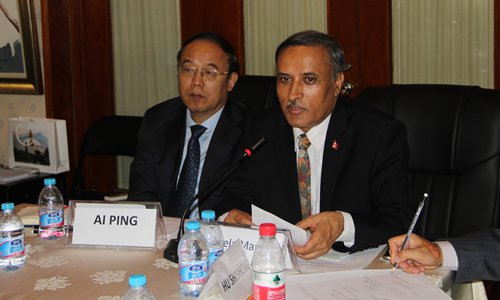Create a firm basis for peace and tranquility in the region

Nepalese Ambassador to China Leela Mani Paudyal (right) gives a speech at the seminar of Nepal-China Relations for Peace and Prosperity in the Trans-Himalayan Region at the Embassy on August 1. (Photo: Courtesy of the Nepalese Embassy)
Ever since the establishment of diplomatic relations between Nepal and China on August 1, 1955, the age-old and deep-rooted relations have continued to flourish in multiple dimensions. Marked by profound friendship between the two peoples, and understanding and appreciation of each other's aspirations and sensitivities, the countries' relations have stood the tests of time.
It is a matter of great satisfaction that Nepal and China value each other's independence, sovereignty and territorial integrity and respect and accommodate each other's concerns and interests. Nepal abides by its commitment to the one-China policy, and is steadfast in its resolve not to let its soil to be used for any anti-China or separatist activities. Moreover, Nepal also strongly supports the efforts made by China in upholding its state sovereignty, national unity and territorial integrity.
It is in this context that the cordiality and friendliness of our relations have not only created a firm basis for peace and tranquility in the region but also set an excellent example of good neighborly relations between nations everywhere.
On May 12, the government of Nepal and the government of China signed the Memorandum of Understanding (MoU) on Cooperation under the Belt and Road initiative in Kathmandu. The MoU lays emphasis on promoting mutually beneficial cooperation between Nepal and China in various fields of mutual interest, such as economy, environment, technology and culture.
This agreement is of historical importance to both the countries. We in Nepal are confident that it will help build the critical infrastructure in the Himalayan region and remove the barriers for a seamless movement of people, goods and services across the Nepal-China boundary. Moreover, the improvement in transportation and connectivity will help all the countries in the region to integrate their markets and reap the benefits of expanded trade and commerce. The conviction of the MoU on co-operation under the Belt and Road Initiative will be a starting point in that new voyage.
In the 62-year journey of the countries' diplomatic relations, there is a feeling of pride for the remarkable achievements that have been made in various fields of cooperation. More recently, the avenues for bilateral relations between Nepal and China have further widened following the signing of MOU with China on the Belt and Road initiative, and joining Asian Infrastructure Investment Bank as a founding member and Shanghai Cooperation Organization as a dialogue partner.
Chinese support has greatly contributed to Nepal's development efforts, especially in the areas of infrastructure building, establishment of industries, human resource development, health, education, energy, water resources and sports. The first agreement between China and Nepal on economic aid was signed in October 1956. From the mid-1980s, the Chinese government has been pledging grant assistance to the government of Nepal under the Economic and Technical Cooperation Program in order to implement mutually identified development projects.
In the past year alone, there were some significant milestones in Nepal-China co-operation. In December 2016, the two countries signed an agreement for grant assistance of one billion yuan ($14,862,595) from China to Nepal for reconstruction and rehabilitation of earthquake damaged facilities. This grant assistance symbolizes China's generous support to Nepal's development efforts.
In the front of investments from China to Nepal, there have been encouraging developments, and Chinese investors have shown great interest. Out of a total of 250 foreign delegates, 89 participating investors were from China, and out of a total investment pledge of $13.74 billion, China accounted for $8.4 billion (61.13 percent). Recently, a MoU has been signed with China Gezhouba (Group) Corporation for the construction of the Budhigandaki Hydropower storage project. Likewise, the number of Chinese tourists visiting Nepal is also rising rapidly - in the first half of 2017, the number increased by 64 percent compared to the same period last year.
There are huge potentials in Nepal-China that still remain untapped. As the ancient maxim common in Nepal and China goes, "Only with high ambition and hard work can one make great achievements." Therefore, the two countries should build on past achievements and bring about an in-depth and all-round growth in our relations.
(The author is the Nepalese Ambassador to China)

